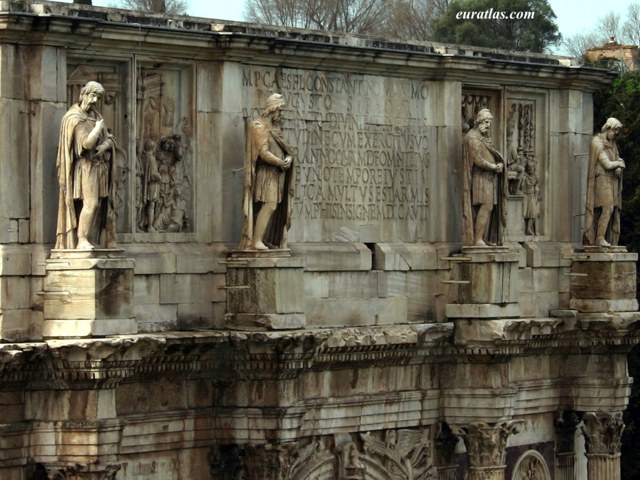[size=1]
In his book entitled De Magistratibus Ioannes Lydus reports that Constantine the Great wrote, in his native (oikeia) tongue, some Discourses which he left to posterity [1]. While avoiding carefully to specify what exactly this native tongue of Constantine was, the Lydian, deliberately or not, gives us a clue. Evidently, Constantine’s “domestic” landuage could not have been Greek; otherwise the adjective (oikeios) would have been out of place, even confusing [2]. Neither could Constantine’s native tongue have been Latin. To designate the Latin tongue otherwise than by its name, Byzantine writers generally used the words patris jonh in his own home?
2. The Lydian wrote his book sometime between years 551 and 564 A.D., when Latin in Constantinople was in full retreat [3]. Justinian himself is said to have spoken broken Latin, and Greek like a barbarian [4]. This was two centuries after the death of Constantine. Clearly, throughout this period, there was in Constantinople people who could read Latin and/or Greek, and also people who could read Constantine’s Discourses, written in his “domestic” language. The Lydian darkly hints that in his time Latin was being pushed out of official business. But, by what other language?
3. There is abundant circumstantial evidence that Constantine the Great was a Thracian, and there is also enough direct evidence to this effect, namely:
i). Constantine’s grandfather, Eutropius, was a Thracian from Dardania [5];
ii). Constantine himself was born and raised in Nish (Naissus), a Thracian (Dardanian) city [6];
iii). He completed his education in Nicomedia, a Thracian city, at the court of Galerius, a Thracian emperor born in Serdica (the modern Sofia). Galerius was so un-Roman that he is believed to have even thought of dropping from the name of the Empire the adjective “Roman” and replacing it by “Dacian”, Dacia at that time being one of the several large Thracian districts [7];
iv). Julian the Apostate, a nephew of Constantine, says several times over that his family was Thracian, from Mysia [8];
v). Constantine himself transferred the Imperial capital away from Rome, to Byzantium, in the heart of Thrace; [/size]
http://forum.skycode.com/topic.asp?whichpage=11&topic_id=62628
Restul articolului de la adresa e protocronist, dar realitatea e ca si Constantin si Iustinian erau de neam daco-tracic.
Constantin era vorbitor de traco-daca. El nu se considera roman ci, ca si Galeriu (care vroia sa transforme imperiul roman în imperiu dacic si sa-i supuna pe romanii din Italia la taxe drept razbunare pentru razboaiele dacice) Constantin se considera dac. Asta se vede cel mai bine din statuile puse pe arcul sau din Roma:

În timpul lui Iustinian cam o treime din Balcani mai vorbea înca limba tracica.
Numele de familie al lui Iustinian, Sabbatius, este traco-dacic.
Belisarie era un traco-dac, inclusiv numele e tracic. Procopius mentioneaza în mai multe rânduri tracii din Balcani (numindu-i bessi, ca si alti autori din sec. 6-7) precum si numele unora, nume perfect tracice: Dityvistus, Zimarchus, Malalas.
Ce vezi tu oriental în Sf. Sofia? Daca nu stii istoria arhitecturii nu mai face pe destul.
Cupola e un element inventat de romani, deci e occidental. Prima data (daca nu ma însel) a fost utilizata la Panteonul din Roma.
Arhitectura crestina a evoluat de la tipul simplu de sala, numita cu numele unui tip de constructie din orasele romane, basilica (având drept utilitate comertul si adunarile publice). Acest tip de edificiu era alungit, era deci de tip nava. Alt tip era cel de plan central, adica circular. Pâna în timpul lui Iustinian cele doua tipuri de constructie (al doilea mult mai putin frecvent) au fost utilizate separat, arhitectii lui Iustinian au avut inspiratia îmbinarii celor doua tipuri de plan într-unul singur. Asta s-a întâmplat întâi la bazilica Sf. Sergiu si Bahus din Constantinopol, realizata cu câtiva ani înaintea Sf. Sofia. Apoi a fost aplicata si la Sf. Sofia.
Si care sunt elementele de la manastirile moldovenesti si bucovinene? Nu stii ca acele monumente sunt în stil gotic adaptat la cultul ortodox?